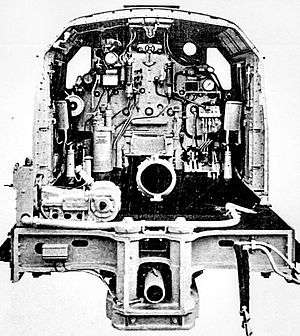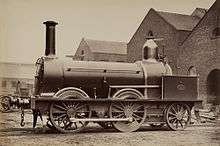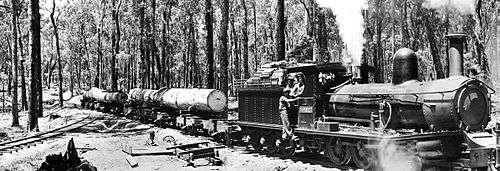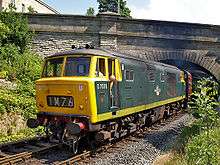Beyer, Peacock and Company
| Industry | Locomotive manufacturer |
|---|---|
| Founded |
1854 England |
| Founders |
Charles Beyer Richard Peacock Henry Robertson |
| Defunct | 1966 |
| Website |
beyerpeacock |

Beyer, Peacock and Company was an English railway locomotive manufacturer with a factory in Gorton, Manchester. Founded by Charles Beyer, Richard Peacock and Henry Robertson, it traded from 1854 until 1966. It received limited liability in 1902, becoming Beyer, Peacock and Company Limited.
In 1854, the German born Charles Beyer resigned as head engineer at Atlas works (Sharp Roberts and Co). It was Beyer that was responsible for success of locomotive production at Atlas. He had trained under the guidance of the prolific inventor of cotton mill machinery, Richard Roberts.
Richard Peacock resigned from his position as chief engineer of the Manchester, Sheffield and Lincolnshire Railway's locomotive works in Gorton in 1854. Confident in his ability to secure orders to build locomotives, Beyer’s resignation presented Peacock with a partnership opportunity. However, this was not a limited company and all partners were liable for debts should the business fail; in a mid-Victorian economic climate of boom and bust, it was a risky venture. Beyer could raise £9,524 (nearly £900,000 in 2015) and Peacock £5,500 but still required a loan from Charles Geach (founder of the Midland Bank, and first treasurer to the Institution of Mechanical Engineers). Beyer and Peacock were founder members of the Institution of Mechanical Engineers, but Geach died, the loan was recalled and the whole project nearly died. To the rescue came Thomas Brassey who persuaded Henry Robertson to provide a £4,000 loan in return for being the third (sleeping) partner.[1]
.jpg)
Beyer appointed and worked closely with Hermann Ludwig Lange (1837–92), in 1861. A native of his home town, Plauen, Saxony (now Germany), Langer trained as an engineer in Germany, became chief draughtsman in 1865, and chief engineer after Beyer`s death. Langer was heavily involved in the development of the world's first successful condensing locomotives for the Metropolitan Railway, This 4-4-0 tank engine can, therefore be considered as the pioneer motive power on London's Underground London's first underground railway[8]. These locomotives proved to be extremely successful and 148 were built between 1864 and 1886 for various railways including the District Railway, London, in 1871, most still running until electrification in 1905.[1]
Beyer Peacock exported locomotives and machine tools to service them all over the world
Important designs were the Garratt articulated locomotives widely used in Africa, notably on South and East African Railways, and Australia and the 4-4-0 tank locomotives used on the Metropolitan and District Railways in London from 1864 until electrification in 1905. They also built 2-4-0 tank locomotives for 3 ft 6 in (1,067 mm) lines in Norway and the famous Manx Peacock design for the 3 ft (914 mm) gauge Isle of Man Railway
The first Garratt locomotive constructed was the Tasmanian Government Railways K class on the western Tasmanian North East Dundas Tramway; K1 is now preserved on the Welsh Highland Railway together with the last Garratt Beyer Peacock built SAR NGG 16 Class No.143. Four New South Wales Government Railways AD60 class Beyer-Garratt Patent locomotives are preserved being the most powerful steam locomotives in the southern hemisphere when introduced.
Gorton Foundry was on the opposite (south) side of the railway line to the Manchester, Sheffield and Lincolnshire Railway works at Gorton. Between 1855 and 1966, the company built nearly 8,000 railway locomotives. Several of their 1874-built steam locomotives for the Isle of Man Railway remain in daily use. A Gorton-built South African Railways GL class Beyer-Garratt locomotive is on display in the Museum of Science and Industry in Manchester.
In addition to building steam locomotives, Beyer, Peacock & Co. also built the 10 British Rail Class 82, 25 kV AC electric locomotives to a Metropolitan-Vickers design, the 101 British Rail Class 35 diesel hydraulic locomotives, and, the last of all built, British Rail Class 25/3 diesel-electrics. They also collaborated with Metropolitan Vickers in building the Western Australian Government Railways X class, diesel electric locomotives, and the New South Wales 46 class, 1500 V DC electric locomotives at Bowesfield Works, Stockton-on-Tees.

Gorton Foundry
The foundry was at Openshaw near Manchester, England, and was built in 1854 and designed mainly by Beyer. The site was chosen because land was cheaper than in the city and had good water supply from a local reservoir (It should not be confused with the Gorton locomotive works of the Manchester, Sheffield and Lincolnshire Railway, locally known as Gorton Tank which was on the north side of the railway line, which had been built by Richard Peacock, when he was chief engineer, before he resigned and joined forces with Beyer to form Beyer-Peacock.). Beyer had designed the works so it always allowed room for expansion. In its 112-year history no buildings needed to be demolished as the works developed.
In 2012 the former boiler-shop remains in use, as the Hammerstone Road Depot of Manchester City Council.
Locomotives produced
Steam
- 1928 LNER B12 / GER Class S69 4-6-0
Conventional


- 1864–1885 Metropolitan Railway 4-4-0T – see Metropolitan Railway A Class
- 1871–1886 District Railway 4-4-0T
- 1873–1926 Isle of Man Railway 2-4-0T – see Isle of Man Railway locomotives
- 1898 Tobu Railway B1 class 4-4-0 (12 locos)[2]
- 1911 WAGR G class 4-6-0 (7)
- 1921 Rhymney Railway R class 0-6-2T (6)
- 1931 GWR 5700 Class (25)
- 1952 WAGR W class 4-8-2 (60)
Beyer-Garratts
- 1909 Tasmanian Government Railways K class
- 1910 DHR D Class
- 1925 LNER Class U1
- 1926 Victorian Railways G class
- 1927 LMS Garratt
- 1928 NZR G class
- 1928 SAR GL Class
- 1939 South African Class NG G16
- 1940-52 Rhodesia Railways_15th_class
- 1951 Queensland Beyer-Garratt class
- 1951 South Australian Railways 400 class (under licence by Societe Franco-Belge)
- 1952 New South Wales AD60 class locomotive of the NSWGR
- 1954-68 Rhodesia Railways 20th class
- 1955 EAR 59 class of the EAR
- 1956 South African Railways GMA/M Class
Steam turbine
Beyer-Ljungstrom Turbine Locomotive The Beyer-Ljungstrom Turbine Locomotive
Diesel


- 1954–56 Western Australian Government Railways X class, built at Bowesfield Works, Stockton-on-Tees.
- 1961–63 British Rail Class 35
- 1962 British Rail Class 25
- 1964 British Rail Class 17
Electric
- 1956–58 New South Wales 46 class, built at Bowesfield Works, Stockton-on-Tees.
- 1960–62 British Rail Class 82
Preserved locomotives
Steam locomotives
Diesel and electric locomotives
| Preserved Locomotives | ||||||||
|---|---|---|---|---|---|---|---|---|
| BP No. | Built | Company built for | Locomotive number(s) | Class | Wheel arrangement | Preserved at | ||
| 1956 | NSWGR | 4601 | 46 Class | Co-Co | Valley Heights Locomotive Depot Heritage Museum | |||
| 1956 | NSWGR | 4602 | 46 Class | Co-Co | Dorrigo Steam Railway & Museum | |||
| 1956 | NSWGR | 4615 | 46 Class | Co-Co | Junee Roundhouse Museum on permanent loan from the Sydney Electric Train Society | |||
| 1956 | NSWGR | 4617 | 46 Class | Co-Co | Privately owned, Junee (cab only) | |||
| 1956 | NSWGR | 4627 | 46 Class | Co-Co | Sydney Electric Train Society | |||
| 1956 | NSWGR | 4638 | 46 Class | Co-Co | NSW Rail Museum, Broadmeadow Locomotive Depot[3] | |||
| 1961 | British Railways | E3054, 82008 | BR Class 82 | Bo-Bo | Barrow Hill Engine Shed | |||
| 7911 | 1962 | British Railways | D7017 | BR Class 35 Hymek | B-B | West Somerset Railway | ||
| 7912 | 1962 | British Railways | D7018 | BR Class 35 Hymek | B-B | West Somerset Railway | ||
| 7923 | 1962 | British Railways | D7029 | BR Class 35 Hymek | B-B | Severn Valley Railway | ||
| 7980 | 1963 | British Railways | D7076 | BR Class 35 Hymek | B-B | East Lancs Railway | ||
| 8038 | 1965 | British Railways | D7628, 25278 Sybilla | BR Class 25 | Bo-Bo | North Yorkshire Moors Railway - Operational | ||
| 8039 | 1965 | British Railways | D7629, 25279 | BR Class 25 | Bo-Bo | Great Central Railway (Nottingham) - Operational | ||
| 8043 | 1965 | British Railways | D7633, 25283 | BR Class 25 | Bo-Bo | Dean Forest Railway - Operational | ||
Notes
- ↑ Bruce, J Greame (1971). Steam to Silver. London: London Transport. ISBN 978-0853290124.
- 1 2 3 Tobu Museum exhibit guide Archived 22 December 2008 at the Wayback Machine. Retrieved on 11 March 2009 (in Japanese)
- ↑ "Veteran Electric Finds New Home as In-Traffic Units Face Uncertain Future" Railway Digest July 1998 page 10
References
- Hills, R. L.; Patrick, D. (1982). Beyer, Peacock, locomotive builders to the world. Glossop: Transport Publishing Co. ISBN 0-903839-41-5.
Bibliography
- Lowe, James W. (1989) [1975]. "Beyer, Peacock & Company". British Steam Locomotive Builders. London: Guild Publishing. pp. 59–64. ISBN 0900404213.
External links
| Wikimedia Commons has media related to Beyer, Peacock and Company locomotives. |